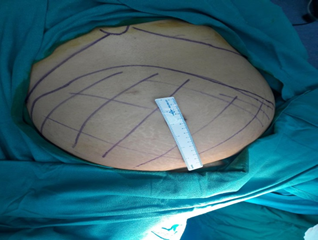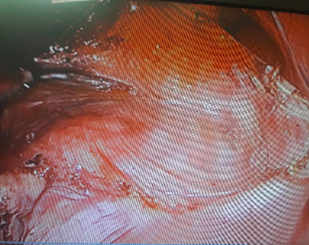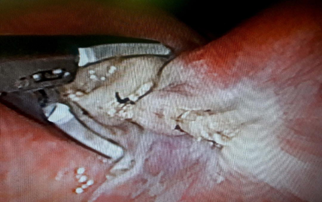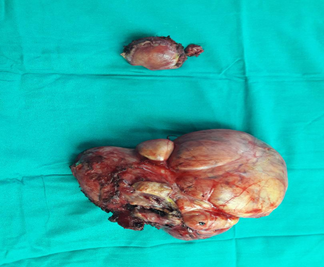Management of Giant Cervical Fibroid By “Hybrid Technique”
Kanika Chopra*, Debasis Dutta, Kanika Jain
Department of Minimally Invasive Gynaecology, Institute of Obstetrics and Gynaecology, Sir Ganga Ram Hospital, New Delhi
*Corresponding Author: Kanika Chopra Department of Minimally Invasive Gynaecology, Institute of Obstetrics and Gynaecology, Sir Ganga Ram Hospital, New Delhi
Received: 25 April 2018; Accepted: 30 April 2018; Published: 03 May 2018
Article Information
View / Download Pdf Share at FacebookAbstract
Cervical fibroids are a rarity as compared to fibroids arising from other parts of the uterus. These rare fibroids account for 1-2% of all fibroids. They arise from supravaginal or vaginal portion of cervix. They can be either anterior, posterior, central or lateral. Our case is unique in many ways, firstly the huge size of the tumor, its rapid growth and its management laparoscopically. We report a case of 47-year-old female who presented with complain of pain abdomen and menorrhagia since last 10 years. Abdominal examination revealed a huge firm mass corresponding to 34 weeks size gravid uterus with well defined margins. The lower pole of the mass could not be reached and mobility was not there due to its size. MRI revealed a large fibroid arising from the posterior wall of the cervix displacing the uterus to the left and anteriorly. After necessary investigations, arranging adequate blood and written informed consents, patient was taken up for laparoscopic hysterectomy. Intraoperative findings were of a large cervical fibroid seen extending from depth of the pelvis uptil four inches below xiphisternum and abutting right lateral wall. Uterus was deviated to the left side by the tumor. Left tube and ovary were normal looking, but right tube was stretched over the tumor along with the ovary. Hysterectomy was done including the separation of the fibroid from all its attachments, but in view of large size of the mass and high suspicion of sarcomatous changes within the tumor, laparotomy was done to deliver out the tumor with uterus and bilateral adnexa. The operative time was around 3 hours and estimated blood loss during the surgery was around 500ml. Patient was given 2 units of PCV and 2 units of FFP’s. Her postoperative period was uneventful. Histopathology report was in conformity with that of a cervical fibroid. To conclude, management of such cases laparoscopically helps in decreasing blood loss during surgery to a large extent and helps in decreasing p
Keywords
Huge cervical fibroid uterus; Total laparoscopic hysterectomy; Sarcomatous degeneration; Minimal invasive surgery
Huge cervical fibroid uterus articles Huge cervical fibroid uterus Research articles Huge cervical fibroid uterus review articles Huge cervical fibroid uterus PubMed articles Huge cervical fibroid uterus PubMed Central articles Huge cervical fibroid uterus 2023 articles Huge cervical fibroid uterus 2024 articles Huge cervical fibroid uterus Scopus articles Huge cervical fibroid uterus impact factor journals Huge cervical fibroid uterus Scopus journals Huge cervical fibroid uterus PubMed journals Huge cervical fibroid uterus medical journals Huge cervical fibroid uterus free journals Huge cervical fibroid uterus best journals Huge cervical fibroid uterus top journals Huge cervical fibroid uterus free medical journals Huge cervical fibroid uterus famous journals Huge cervical fibroid uterus Google Scholar indexed journals Total laparoscopic hysterectomy articles Total laparoscopic hysterectomy Research articles Total laparoscopic hysterectomy review articles Total laparoscopic hysterectomy PubMed articles Total laparoscopic hysterectomy PubMed Central articles Total laparoscopic hysterectomy 2023 articles Total laparoscopic hysterectomy 2024 articles Total laparoscopic hysterectomy Scopus articles Total laparoscopic hysterectomy impact factor journals Total laparoscopic hysterectomy Scopus journals Total laparoscopic hysterectomy PubMed journals Total laparoscopic hysterectomy medical journals Total laparoscopic hysterectomy free journals Total laparoscopic hysterectomy best journals Total laparoscopic hysterectomy top journals Total laparoscopic hysterectomy free medical journals Total laparoscopic hysterectomy famous journals Total laparoscopic hysterectomy Google Scholar indexed journals Sarcomatous degeneration articles Sarcomatous degeneration Research articles Sarcomatous degeneration review articles Sarcomatous degeneration PubMed articles Sarcomatous degeneration PubMed Central articles Sarcomatous degeneration 2023 articles Sarcomatous degeneration 2024 articles Sarcomatous degeneration Scopus articles Sarcomatous degeneration impact factor journals Sarcomatous degeneration Scopus journals Sarcomatous degeneration PubMed journals Sarcomatous degeneration medical journals Sarcomatous degeneration free journals Sarcomatous degeneration best journals Sarcomatous degeneration top journals Sarcomatous degeneration free medical journals Sarcomatous degeneration famous journals Sarcomatous degeneration Google Scholar indexed journals Minimal invasive surgery articles Minimal invasive surgery Research articles Minimal invasive surgery review articles Minimal invasive surgery PubMed articles Minimal invasive surgery PubMed Central articles Minimal invasive surgery 2023 articles Minimal invasive surgery 2024 articles Minimal invasive surgery Scopus articles Minimal invasive surgery impact factor journals Minimal invasive surgery Scopus journals Minimal invasive surgery PubMed journals Minimal invasive surgery medical journals Minimal invasive surgery free journals Minimal invasive surgery best journals Minimal invasive surgery top journals Minimal invasive surgery free medical journals Minimal invasive surgery famous journals Minimal invasive surgery Google Scholar indexed journals cervix articles cervix Research articles cervix review articles cervix PubMed articles cervix PubMed Central articles cervix 2023 articles cervix 2024 articles cervix Scopus articles cervix impact factor journals cervix Scopus journals cervix PubMed journals cervix medical journals cervix free journals cervix best journals cervix top journals cervix free medical journals cervix famous journals cervix Google Scholar indexed journals cervical articles cervical Research articles cervical review articles cervical PubMed articles cervical PubMed Central articles cervical 2023 articles cervical 2024 articles cervical Scopus articles cervical impact factor journals cervical Scopus journals cervical PubMed journals cervical medical journals cervical free journals cervical best journals cervical top journals cervical free medical journals cervical famous journals cervical Google Scholar indexed journals menstrual periods articles menstrual periods Research articles menstrual periods review articles menstrual periods PubMed articles menstrual periods PubMed Central articles menstrual periods 2023 articles menstrual periods 2024 articles menstrual periods Scopus articles menstrual periods impact factor journals menstrual periods Scopus journals menstrual periods PubMed journals menstrual periods medical journals menstrual periods free journals menstrual periods best journals menstrual periods top journals menstrual periods free medical journals menstrual periods famous journals menstrual periods Google Scholar indexed journals ultrasound abdomen articles ultrasound abdomen Research articles ultrasound abdomen review articles ultrasound abdomen PubMed articles ultrasound abdomen PubMed Central articles ultrasound abdomen 2023 articles ultrasound abdomen 2024 articles ultrasound abdomen Scopus articles ultrasound abdomen impact factor journals ultrasound abdomen Scopus journals ultrasound abdomen PubMed journals ultrasound abdomen medical journals ultrasound abdomen free journals ultrasound abdomen best journals ultrasound abdomen top journals ultrasound abdomen free medical journals ultrasound abdomen famous journals ultrasound abdomen Google Scholar indexed journals anaesthesia articles anaesthesia Research articles anaesthesia review articles anaesthesia PubMed articles anaesthesia PubMed Central articles anaesthesia 2023 articles anaesthesia 2024 articles anaesthesia Scopus articles anaesthesia impact factor journals anaesthesia Scopus journals anaesthesia PubMed journals anaesthesia medical journals anaesthesia free journals anaesthesia best journals anaesthesia top journals anaesthesia free medical journals anaesthesia famous journals anaesthesia Google Scholar indexed journals Uterus articles Uterus Research articles Uterus review articles Uterus PubMed articles Uterus PubMed Central articles Uterus 2023 articles Uterus 2024 articles Uterus Scopus articles Uterus impact factor journals Uterus Scopus journals Uterus PubMed journals Uterus medical journals Uterus free journals Uterus best journals Uterus top journals Uterus free medical journals Uterus famous journals Uterus Google Scholar indexed journals
Article Details
1. Introduction
Fibroids are smooth muscle tumors, that develop within the myometrium, but occasionally can be seen arising from cervix, broad ligament and even ovaries. The incidence of cervical fibroids is 1-2% [1,2]. The presence of cervical fibroid in the absence of an abnormal uterus is a rare finding. We report a rare case of a very large cervical fibroid which was optimally managed laparoscopically, although we did laparotomy to remove the mass in toto owing to the high suspicion of sarcomatous changes within the fibroid. Management of such large fibroid laparoscopically is technically demanding and requires exceptional skills.
2. Case
A 47-year-old lady para 2live 2, presented at Sir Ganga Ran Hospital with complaints of pain abdomen and menorrhagia since last 10 years. Pain abdomen was dull aching in nature and aggravated during her menstrual periods. Bleeding per vaginum was associated with passage of clots and was not responding to medical management. There was no history of any chronic illness or surgery. On examination, patient was average built, her vitals were stable and pallor was present. Her general, cardiovascular and central nervous system examination was within normal limits. On per abdominal examination, a large firm mass was palpable corresponding to 34 weeks gravid uterus with its lower pole not palpable. The mobility of the mass was absent owing to its huge size, the margins of the mass was well defined and it was non-tender. No free fluid was appreciable per abdomen. On per speculum examination, cervix could not be seen and vagina was healthy. On per vaginum examination, cervix was felt effaced over the mass and pulled towards the symphysis pubis and mass was felt arising from the posterior lip of the cervix. Uterus could not be felt separately from the mass and fornices were pushed down, pouch of douglas was free. Per rectal examination revealed the same mass and rectal mucosa was free with no nodularity. Her investigations were, haemoglobin 8.9 mg%, total leucocyte count 7600, platelet count 2.69 lakhs, blood urea nitrogen 6.7 mg%, serum creatinine 0.5 mg/dl, CA125 18.09 U/ml, liver function test and coagulation profile within normal limits.
Patient came with an ultrasound abdomen done in 2009 for the same complaint and its findings were of a fibroid of 3.3 × 2.3 cm in upper part of the posterior lip of the cervix and a bulky uterus, but no active management was done for it then. A recent ultrasound whole abdomen was then done as patient presented to us and was suggestive of normal upper abdomen organs and a large mildly enhancing solid mass lesion of size 22 × 16 × 18 cm in right adnexa arising from the level of pelvic floor and extending up to the level of L3 vertebrae, displacing uterine fundus to the left side, ileocecal region, terminal illeal loops superiorly and rectosigmoid laterally causing extrinsic compression on the right ureter. No evidence of fat or calcification noted within the mass. Right ovary could not be seen due to the mass, but left ovary was seen and normal looking. No free fluid was seen. The impression of broad ligament fibroid or an ovarian mass was made on the ultrasound evaluation. MRI pelvis was then done for further and optimistic evaluation prior to taking the patient for surgery. A large mass of 25 × 19 × 14 cm was noted arising from the posterior wall of the cervix with foci of necrosis in the periphery of the lesion displacing the uterus to the left and anteriorly. The endometrium and myometrium appeared normal. No evidence of pelvic lymphadenopathy was noted neither any evidence of free fluid. Patient was admitted, pre-anaesthetic check-up done, adequate blood arranged and after written informed consents, patient was taken up for laparoscopic hysterectomy.
After, general anaesthesia and patient positioning, preoperative finding were confirmed and surface marking was done as seen in Figure 1. Pneumoperitoneum was created via palmer’s point and 5 mm trocar introduced under vision with the help of 5 mm 30-degree scope and camera head attached to it. Further trocars were placed as per the need and availability of the space. The intraoperative findings were a large mass arising from the depth of the pelvis, extending till 4 inches short of xiphisternum and adjourning right lateral abdominal wall deviating uterus to the left side. Uterus was bulky, left adnexa was normal looking, right ovary was lying adjacent to the mass and right tube was stretched over it. Diluted vasopressin in the ratio of 1:10 was injected in the uterus to devascularize it. Left infundibulopelvic and round ligament was desiccated and divided. Left sided broad ligaments were desiccated and divided. Bladder dissected free from lower uterine segment as seen in Figure 2. Left uterine artery skeletonized and endosutured. Right sided infundibulopelvic and round ligament were approached with difficulty (Figure 3) after mobilising the large fibroid, desiccated and divided. Fibroid was sequentially separated from all its attachments, while remaining within the capsule at all time. Right uterine artery then skeletonized and endosutured.
Vaginal vault then opened circumferentially. In view of the large size of the mass leading to a high suspicion of sarcomatous changes within the fibroid and thus avoiding morcellation, laparotomy was done to deliver the mass in toto along with the uterus and bilateral adnexa. Vault was then sutured and haemostasis achieved. The weight of the fibroid (Figure 4) was 4 kilograms measured post operatively. Total blood loss estimated was around 500 ml. 2 units PCV and 2 units FFP were transfused postoperatively. Deep venous thromboprophylaxis was given postoperatively for 5 days. Patient had a satisfactory recovery and was discharged on postoperative day sixth. The histopathology report was uterus with secretory endometrium and myometrium unremarkable. The larger piece measured 23 × 23 × 12 cm and showed lower part of uterus along with cervical lip in which a large fibroid was attached suggestive of a cervical fibroid. Outer surface of the fibroid showed multiple bosselations. Cut surface of the fibroid showed areas of haemorrhage. Bilateral adnexa revealed no significant abnormality.

Figure 1: Surface marking of mass prior to starting laparoscopic hysterectomy.

Figure 2: Bladder dissected free from lower uterine surface.

Figure 3: Right infundibulopelvic ligament being desiccated and divided.

Figure 4: Huge cervical fibroid and the uterus post operatively.
3. Discussion
Fibroids are common benign tumors of the uterus and are composed of muscles and fibrous connective tissue. The incidence of these tumors is around 20-25% [3]. Most of the fibroids are limited to the body of the uterus, but only 1-2% arise from the cervix. Most cervical fibroids are supravaginal in location, but can be vaginal as well. These fibroids cab be placed anteriorly, posteriorly, central or lateral and in few cases these can be multiple. These fibroids present as retention of urine, constipation, foul smelling vaginal discharge, as mass coming out of vagina [4, 5] lump abdomen or with pressure changes. The large size of cervical fibroid leads to distortion of anatomy of ureter, bladder and uterine vessels and thus increasing risk of injury to these structures. Also, it’s seen that the presence of cervical fibroid without any uterine abnormality is a rare finding. So, correct knowledge of the altered anatomy and proper technique is a key to success in such cases. Use of laparoscopy in these cases is technically demanding requiring good team effort and exceptional surgeon’s skills. Our case presented as pain abdomen with menorrhagia and the mass abdomen was corresponding to 34 weeks gravid uterus and MRI pelvis confirmed the diagnosis of large cervical fibroid. We did laparoscopic hysterectomy followed by laparotomy to remove the fibroid. In our case it helped in decreasing blood loss and also helped in limiting the size of the incision to deliver out the mass in toto owing to the high suspicion of sarcomatous changes within. There was no injury to adjoining vital organs like bladder, ureter or bowel loops as seen in other similar cases reported previously. The procedure was completed in 3 hours and estimated blood loss was 500ml and weight of the cervical fibroid was 4 kg.
In a series of cases reported by Kentaro Nakayama et al6, in case 1 patient was a 51-year-old, P2L2 with MRI suggestive of 108 × 103 × 90 mm cervical fibroid on left side of posterior wall of uterine cervix. Total laparoscopic hysterectomy was done. Blood loss was 1380 ml and weight of extracted uterus was 1.1kg. in case 2 , patient was 51 year old, P3L2 (previous 2 caesareans) and MRI revealed a cervical fibroid of 60.3 × 52.4 × 57.8 mm on left size of the posterior wall of uterine cervix and another fibroid of 6.3 × 52.4 × 57.8mm on median line of anterior wall. Total laparoscopic hysterectomy (TLH) was done, blood loss in this case was minimal and weight of the excised uterus was 501.5 gm. In other case reported, patient was 60 year old, P3L2 and on MRI cervical fibroid was 110 × 105 × 85mm. TLH was done, blood loss was 400 ml and the weight of the uterus was 605gm. In all these case vesicouterine ligament was dissected which helped in safely separating ureter from cervix. Bilateral pelvic walls were dissected from ipsilateral sides to avoid cervical fibroid hindering movement of instruments. It has been seen that the rate of conversion to laparotomy was 4.2-9.7% and in these cases a smaller incision in the abdominal wall was necessary to extract the specimen in 21% of the cases [7].
In another case reported by John C Ekweani et al. [8], the lady was 45-year-old, who had history of heavy menstrual bleeding and her examination revealed a huge cervical fibroid of 21 weeks. She underwent total abdominal hysterectomy. Intraoperative findings were of a large cervical fibroid of 20 × 13 cm. ureteric injury was encountered and managed thereafter. Blood loss was 600 ml.
Sunil Kumar Samal et al. [9] reported a case of a cervical fibroid corresponding to 28 weeks size gravid uterus in a 48-year-old female. Laparotomy was done and was suggestive of a huge central cervical fibroid of 25 × 20 × 15 cm, total abdominal hysterectomy was proceeded with uneventful postoperative period. Similarly, B Kavitha et al. [10] reported a case of a large central cervical fibroid of 20 weeks size. Transection of right ureter, accidental ligation of left ureter and bladder injury was encountered in this case while proceeding to total abdominal hysterectomy and was managed with the help of urologists.
So, to conclude cervical fibroids are a rarity as far as location of fibroids in other parts of the uterus are concerned. Consequently, surgical management also present as a technical challenge. Distorted anatomy leading to difficulty in identification of uterine vessels and ureter, limited visual field and space due to huge size of the mass along with poor uterine mobility, increases the difficulty level while performing laparoscopic hysterectomy in such cases and thus require good surgical skills.
References
- Kaur AP, Saini AS, Kaur D, et al. Huge cervical fibroid- unusual presentation. The Journal of Obstetrics and Gynaecology of India 52 (2002): 164.
- Tiltman, Andrew J. Leiomyoma of the uterine cervix: a study of frequency. International Journal of Gynaecological Pathology 17 (1998): 231-234.
- Buttram VC Jr, Reiter RC. Uterine leiomyomata: etiology, symptomatology and management. Fertil Steril 36 (1981): 433.
- Dutta DC. Benign lesions of the uterus. In: Konar H, eds. Textbook of Gynaecology including contraception. 5th edition. Kolkata. New Central Book Agency (P)LTD. (2009): 262.
- Suneja A, Taneja A, Guleria K, et al. incarcerated procidentia due to cervical fibroid: an unusual presetation. Aust NZJ Obstet Gynecol 43 (2003): 252-253.
- Nakayama et al. TLH for enlarged cervical myoma. Molecular and Clinical Oncology 6 (2017): 655-660.
- Uccella S, Cromi A, Serati M, et al. Laparoscopic hysterectomy in case of uteri weighing 1 kilogram: A series of 71 cases and review of literature. J Minim Invasive Gynecol 21 (2014): 460-465.
- Ekweani JC, Oguntaya OA, Kolawale A, et al. Huge cervical fibroid. Port Harcourt Med J 10 (2016): 135-138.
- Samal SK, Rathod S, Rajsekaran A, et al. An unusual presentation of central cervical fibroid: a case report. Int J Res Med Sci 2 (2014): 1226-1228.
- Kavitha B, et al. Cervical fibroid with “Lantern on top of St Paul “appearance. Int J Res Dev Health 2 (2014): 45-47.


 Impact Factor: * 3.2
Impact Factor: * 3.2 Acceptance Rate: 76.63%
Acceptance Rate: 76.63%  Time to first decision: 10.4 days
Time to first decision: 10.4 days  Time from article received to acceptance: 2-3 weeks
Time from article received to acceptance: 2-3 weeks 